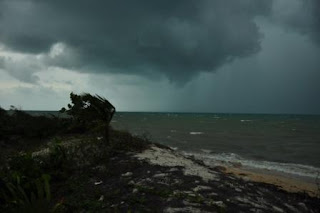Hurricane Isaac
Friday August 24 to Sunday August 26th
Well, while Tropical Storm (later Hurricane) Isaac was felt significantly in Haiti and the Dominican Republic, we here on the Island of Eleuthera felt the tail-end effect. We experienced periods of intense/sudden thunder/lightning storms, rain, and the most unbelievable winds! I believe at some point winds reached 40 knots or Gale force winds. I think the craziest part were people going out wind surfing (see pic below)! Not going to lie, I enjoyed having the tropical storm pass us as it alleviated the bugs (mosquitoes and no-see-ums) for a few days. Just enough time for my arms and legs to heal enough so that when the bugs came back they would have more to feast on lol.
The pictures below were taken right before the sky opened up and unleashed it's fury!
Wet Lab Experiments
Monday August 27 and Wednesday August 29
Last week I got to take part in some very interesting ongoing physiological experiments on 4 different Caribbean fish species: Bonefish, Puffer Fish, Schoolmaster Snapper, and Mojarra. Physiology, in layman's terms, is the study into how organisms function. With increasing concern regarding "climate change" and "global warming", scientists are interested to see how changing pH and temperature could affect various marine species. We were conducting these physiolocial tests to determine how species, such as the bonefish, function in changing environmental conditions such as decreasing pH, and increasing/decreasing temperature. We wanted to determine at which temperature or pH is too much for the species to handle, and therefore cause them to loose equilibrium (roll onto their back). This is called their critical temperature maximums, critical temperature minimums, and critical pH.
I had the opportunity to help set up the system used in the experiment which was challenging but very interesting! Using a combination of PVC tubes, water pumps, hoses, totes, and coolers, we constructed this "raceway" where we can contain the fish and control a particular environmental condition by continuously circulating the same water through the system. Airstones, which are porous stones that are connected to an air supply that diffuse air into the water, were added to help maintain the dissolved oxygen for the fish. The totes, in which the fish were placed, have 6 holes placed a couple inches from the top of the case to allow old water to filter out as new water is continually being added to each holding container. These experiments lasted only an hour or so and is very interesting to see how different species react to different environmental conditions.
After the tests were concluded, fish were moved to recovery tanks where they remained for a few days and then they were released back into the ocean.
The bonefish (see below) are part of an ongoing collaborative, and volunteer tagging program in order to assess their growth and movement patterns throughout the Bahamas. Bonefish, once well recovered from the tests, were tagged and released. Two were released into the artificial (planted) mangrove, and the rest released back in the ocean. The artificial mangrove that we have on campus had one lone bonefish for the longest time! Once we saw him fraternizing with the Cuda (barracuda) we decided it was time to give him some friends to hang out with. Within seconds of the two tagged bonefish (I named them Bonnie and Clyde) being released into the mangroves, the lone bonefish swam straight over! I think he was finally happy to have a group to swim with. They have been inseparable ever since!
Field Work
Tuesday August 28, Thursday August 30, Friday August 31
I also had an opportunity to get out into the field to try and catch some more bonefish, mojarra and snapper. On Tuesday the Flats team went out with the Sharks team for a joint seining attempt. This involved going out at high tide to one of the flats (can't remember which one at the moment), setting up the seine net at the flat entrance, and sitting in the water for 3 hours to wait for the tide to go down (Let me tell you, that is the life).
We caught two sea turtles, quite a few juvenile lemon sharks, but no bonefish....again. On Thursday we went out to try and catch some desperately needed bonefish (down to 9 in the wet lab). We caught some mojarra, a 4 ft nurse shark, but once again no bonefish. I saw a school of 15 lemon sharks...no bonefish. Possible tiger shark bit a hole in our net, but NO BONEFISH! I am starting to think that i am cursed! Every time the team takes me into the field, we never catch bonefish! So when we went out on Friday, I was determined to redeem myself! We went to a flat called Page Creek in order to restock on schoolmaster snapper. We used a technique called handlining, which involves dangling a piece of fishing line with a sardine baited hook into the mangroves and hoping for a bite, and of the 15 snappers we brought back to the lab, I caught 7 of them!!! I think I found my calling :D
Not only was it a greater fishing day, but it was also a beautiful location, and I finally got to use my underwater camera. Below are some of the photos taken on my camera by myself and another Intern who joined us that day.
Finally, I would also like to report that I did my required check-out dive this last weekend, which means that I should be able to share with you some of my diving adventures and photos along the way!
Until next time!
Sincerely,
Your Master-Snapper-Catcher Field Biologist



















